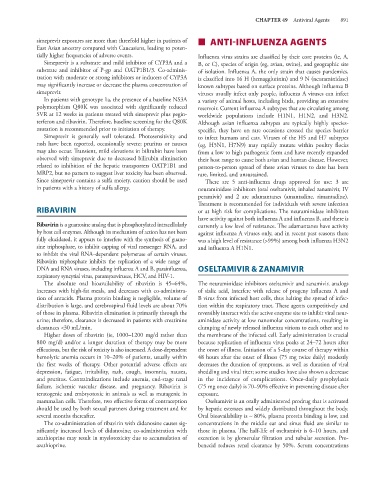Page 905 - Basic _ Clinical Pharmacology ( PDFDrive )
P. 905
CHAPTER 49 Antiviral Agents 891
simeprevir exposures are more than threefold higher in patients of ■ ANTI-INFLUENZA AGENTS
East Asian ancestry compared with Caucasians, leading to poten-
tially higher frequencies of adverse events. Influenza virus strains are classified by their core proteins (ie, A,
Simeprevir is a substrate and mild inhibitor of CYP3A and a B, or C), species of origin (eg, avian, swine), and geographic site
substrate and inhibitor of P-gp and OATP1B1/3. Co-adminis- of isolation. Influenza A, the only strain that causes pandemics,
tration with moderate or strong inhibitors or inducers of CYP3A is classified into 16 H (hemagglutinin) and 9 N (neuraminidase)
may significantly increase or decrease the plasma concentration of known subtypes based on surface proteins. Although influenza B
simeprevir. viruses usually infect only people, influenza A viruses can infect
In patients with genotype 1a, the presence of a baseline NS3A a variety of animal hosts, including birds, providing an extensive
polymorphism Q80K was associated with significantly reduced reservoir. Current influenza A subtypes that are circulating among
SVR at 12 weeks in patients treated with simeprevir plus pegin- worldwide populations include H1N1, H1N2, and H3N2.
terferon and ribavirin. Therefore, baseline screening for the Q80K Although avian influenza subtypes are typically highly species-
mutation is recommended prior to initiation of therapy. specific, they have on rare occasions crossed the species barrier
Simeprevir is generally well tolerated. Photosensitivity and to infect humans and cats. Viruses of the H5 and H7 subtypes
rash have been reported, occasionally severe; pruritus or nausea (eg, H5N1, H7N9) may rapidly mutate within poultry flocks
may also occur. Transient, mild elevations in bilirubin have been from a low to high pathogenic form and have recently expanded
observed with simeprevir due to decreased bilirubin elimination their host range to cause both avian and human disease. However,
related to inhibition of the hepatic transporters OATP1B1 and person-to-person spread of these avian viruses to date has been
MRP2, but no pattern to suggest liver toxicity has been observed. rare, limited, and unsustained.
Since simeprevir contains a sulfa moiety, caution should be used There are 5 anti-influenza drugs approved for use: 3 are
in patients with a history of sulfa allergy. neuraminidase inhibitors (oral oseltamivir, inhaled zanamivir, IV
peramivir) and 2 are adamantanes (amantadine, rimantadine).
Treatment is recommended for individuals with severe infection
RIBAVIRIN or at high risk for complications. The neuraminidase inhibitors
have activity against both influenza A and influenza B, and there is
Ribavirin is a guanosine analog that is phosphorylated intracellularly currently a low level of resistance. The adamantanes have activity
by host cell enzymes. Although its mechanism of action has not been against influenza A viruses only, and in recent past seasons there
fully elucidated, it appears to interfere with the synthesis of guano- was a high level of resistance (>99%) among both influenza H3N2
sine triphosphate, to inhibit capping of viral messenger RNA, and and influenza A H1N1.
to inhibit the viral RNA–dependent polymerase of certain viruses.
Ribavirin triphosphate inhibits the replication of a wide range of
DNA and RNA viruses, including influenza A and B, parainfluenza, OSELTAMIVIR & ZANAMIVIR
respiratory syncytial virus, paramyxoviruses, HCV, and HIV-1.
The absolute oral bioavailability of ribavirin is 45–64%, The neuraminidase inhibitors oseltamivir and zanamivir, analogs
increases with high-fat meals, and decreases with co-administra- of sialic acid, interfere with release of progeny influenza A and
tion of antacids. Plasma protein binding is negligible, volume of B virus from infected host cells, thus halting the spread of infec-
distribution is large, and cerebrospinal fluid levels are about 70% tion within the respiratory tract. These agents competitively and
of those in plasma. Ribavirin elimination is primarily through the reversibly interact with the active enzyme site to inhibit viral neur-
urine; therefore, clearance is decreased in patients with creatinine aminidase activity at low nanomolar concentrations, resulting in
clearances <30 mL/min. clumping of newly released influenza virions to each other and to
Higher doses of ribavirin (ie, 1000–1200 mg/d rather than the membrane of the infected cell. Early administration is crucial
800 mg/d) and/or a longer duration of therapy may be more because replication of influenza virus peaks at 24–72 hours after
efficacious, but the risk of toxicity is also increased. A dose-dependent the onset of illness. Initiation of a 5-day course of therapy within
hemolytic anemia occurs in 10–20% of patients, usually within 48 hours after the onset of illness (75 mg twice daily) modestly
the first weeks of therapy. Other potential adverse effects are decreases the duration of symptoms, as well as duration of viral
depression, fatigue, irritability, rash, cough, insomnia, nausea, shedding and viral titer; some studies have also shown a decrease
and pruritus. Contraindications include anemia, end-stage renal in the incidence of complications. Once-daily prophylaxis
failure, ischemic vascular disease, and pregnancy. Ribavirin is (75 mg once daily) is 70–90% effective in preventing disease after
teratogenic and embryotoxic in animals as well as mutagenic in exposure.
mammalian cells. Therefore, two effective forms of contraception Oseltamivir is an orally administered prodrug that is activated
should be used by both sexual partners during treatment and for by hepatic esterases and widely distributed throughout the body.
several months thereafter. Oral bioavailability is ~ 80%, plasma protein binding is low, and
The co-administration of ribavirin with didanosine causes sig- concentrations in the middle ear and sinus fluid are similar to
nificantly increased levels of didanosine; co-administration with those in plasma. The half-life of oseltamivir is 6–10 hours, and
azathioprine may result in myelotoxicity due to accumulation of excretion is by glomerular filtration and tubular secretion. Pro-
azathioprine. benecid reduces renal clearance by 50%. Serum concentrations

